My car engine hesitates when I accelerate!
Sometimes when we are cruising in our cars and decide to accelerate either slightly or harder we experience an annoying hesitation or stalling. There could be many different factors causing this situation with your car, but many times this hesitation is caused by something that we can take care of by ourselves – a dirty MAF sensor.
You probably know that the MAF sensor receives and senses the amount of air flowing from the outside to the interior of the engine through the intake hose. The ECM uses this sensor to count the incoming air mass, so it can calculate how much fuel can be injected as a minimum and maximum range, without adversely affecting the target air/fuel ratio for the specific needed performance (acceleration in this case).
If the incoming air calculation done by the MAF is wrong because it is dirty, the ECM computer will inject fuel according to the wrong airflow reading. The ECM will usually see a lower incoming airflow when the MAF sensor is dirty, even when there is actually plenty of air coming in. In turn, the ECM will inject a lower fuel amount for the supposedly lower airflow in order to keep the air-fuel ratio, which in turn will end up being too lean. This will produce the hesitation or stalling you are experiencing. In the worst cases, it will include engine knocking.
For more details you may access the information and ordering webpage in the link below::
You may think that you are using in your car a very good air filter, so the MAF sensor could not be the problem, but the bad news is that Airflow sensors (MAF, MAFS, or AFM) get contaminated by lots of microscopic debris that escape the incoming air filter of the vehicle and accumulate overtime on its sensing parts. Such micro-particles that are not stopped by the filter for being too small, end up affecting the MAF sensor accuracy and in turn, engine performance.
Another thing is that gases may reverse from the engine cylinders through the intake valves, all the way back through the intake manifold to the MAF sensor. Take a backfire in the intake manifold as an example, which will cover the MAF sensor elements with a very thin carbon soot film over time, affecting its performance.
THE modern MAF sensors have two essential functionalities to detect the condition of incoming air. The first, for detecting mass instead of volume, it uses a hot wire. By accurately sensing the current flow through that hot wire needed to keep a specific temperature, it can accurately calculate the mass of air present, based on how fast the wire loses its temperature as incoming air dissipates it. It’s simple, the more the incoming air by mass, the more current is needed to keep the reference temperature on the hot wire. Air temperature also affects this calculation and that is what takes us to the second essential functionality, which is the IAT (Intake Air Temperature) sensor. Modern MAF sensors have that IAT sensor integrated inside. The cooler the air, the denser it is, and hence, the more oxygen content by volume. Other factors like altitude are important (the higher the altitude, the rarer the air, the less the oxygen), but this is taken care of by other sensors outside the MAF sensor. That been said, you can imagine how important is to keep clean the surface of such elements inside the MAF sensor. An element coated with dust or soot can not work well at detecting anything of the air surrounding it.
Interested in the full wiring diagram of the ECU connections of the 2005-2007 Toyota Corolla?
(ALWAYS check your SPAM folder in case that you don't see the download in your inbox.)
Your information is safe with us. We take privacy seriously and DO NOT sell or share your information in any way.
Your data will only be used for sending the requested document(s) and for emailing any related information or material that we might offer in any future. If we do so, you will always be provided with a link for unsubscribing if you desire to do so.
Described here is a simple solution to try. You should try this solution before doing any further troubleshooting, as this is a very common situation in fuel-injected cars. The example of this article was based on a 2004-2007 Toyota Corolla MAF sensor, but this will also apply to many other models like the Toyota RAV4 or virtually any car equipped with a MAF sensor or flow meter.
Below is a list of symptoms that your car may show, that tells you it could be a dirty MAF sensor issue.
- If the accelerator is slightly depressed while the car is running and it lags, stalls, or hesitates
- If after completely stopping the car, it stalls when taking off
- Engine power is below the usual level
- Poor fuel economy
- Sometimes check engine light turns on
- Engine knocking*
*May occur for example, when going uphill, because of the lean fuel mixture. This is a rather dangerous situation for the engine when it is a high RPMs.
If the problem is a dirty MAF sensor, the easy solution is to clean it, not replace it, as MAF sensors are expensive, and cleaning it is cheap and very simple. However, MAF sensors besides being expensive, are also delicate electronics. You must do the process with care not to damage the part.
The cleaning
For the example here you will need a #2 Phillips screwdriver for removing the two screws that hold the MAF sensor in place (different architecture in other makes and models) and will also need a spray can of a special MAF sensor cleaning product. This cleaning product is designed to clean without harming the sensitive MAF internal parts and it leaves no residue. The brand “CRC” is an excellent option and it is not expensive at all. The “Mass Air Flow Sensor Cleaner” is available below:
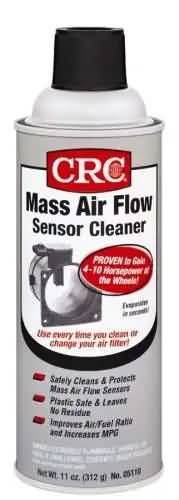
CRC Flowmeter (MAF) cleaner spray
Now, you will need to locate the MAF sensor in your Corolla (or any other model you have). In the Corolla, it is very accessible and no mechanical experience is needed to do this. In the picture below, the location of the MAF sensor of 2004, 2005, 2006, and 2007 Corolla is shown (earlier or later models may also be in the same area). You will find it in the engine compartment, installed somewhere in the air intake path. In this case, it is behind the vehicle’s battery (driver’s side), attached by two #2 Phillips screws. Take the screws out with the #2 Phillips screwdriver.
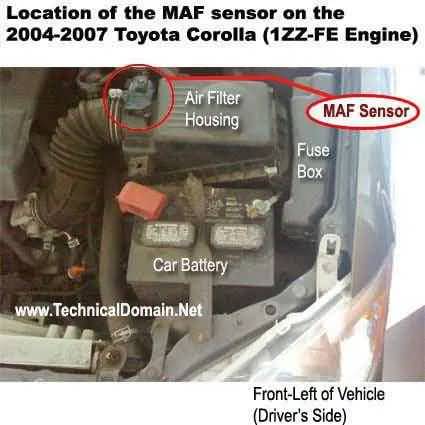
After removing the screws and putting them in a safe place, pull out the MAF sensor. Sometimes it could feel a little bit attached, but if both screws are removed, it will come out. Just pull it gently.
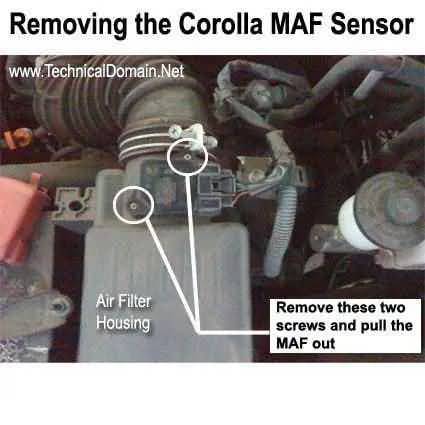
In the next picture, it is shown the MAF sensor that has already been pulled out. Now you must disconnect the attached wiring harness by pushing a plastic lock clip located in the plug itself while pulling the plug at the same time. It will easily come out.
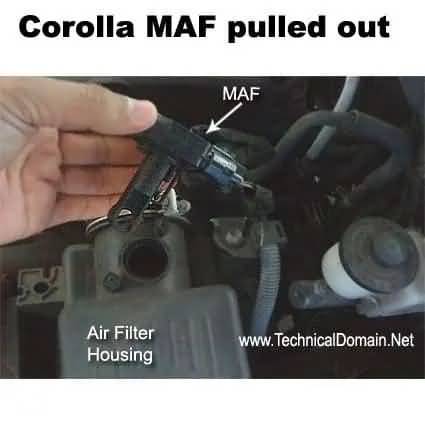

With the MAF sensor already out, put it on a table over a paper towel or a cloth and spray directly to the connector harness with the CRC cleaner to clean the contacts from debris and dust. Just spray it with full force for a couple of seconds. You should wear eye protection on this to avoid the bouncing spray from getting into your eyes. Do this in a well-ventilated area.
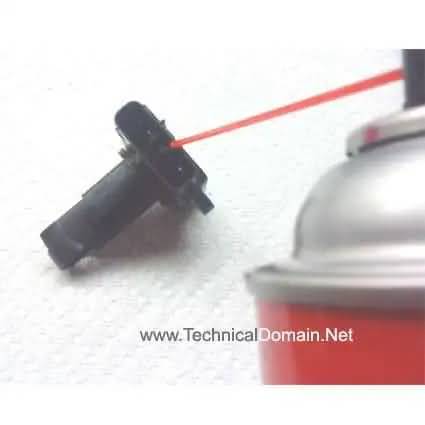
Now, spray with full force inside of the MAF sensor openings for a couple of seconds on each opening. Avoid touching any of the internals of the MAF sensor with the straw of the spray can while spraying into it. After spraying, repeat it once more and then put the MAF sensor upside down, so the excess liquid drips out. Allow enough time for the MAF sensor to be completely dry up before reinstalling it in your vehicle. The CRC chemical is designed to dry almost instantly and leave no residue, but spraying for a few seconds over the surface and internals of the MAF sensor will considerably lower the temperature, causing a mist of water condensation from the environment moisture. That mist will take more time to evaporate than the CRC cleaner’s chemical. A good trick is if you drove your car right before doing this and the engine is still warm, just put the MAF sensor on top of the plastic cover of the engine for at least 15 minutes and the heat will dry it completely.
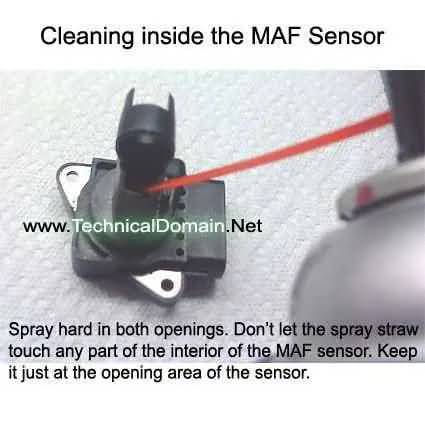
IMPORTANT! Please only use the chemical (spray) described here or one that was designed for similar purposes, which (1) will not harm polymers (plastics), (2) will not harm electrical connections or electronic components (not acidic or caustic), and (3) most important, will not leave any residue when it vaporizes. Chemicals that leave any residue or contain lubricants, like WD-40 for example, may not be used for this specific job. Any residue left inside the MAF sensor will damage it or will make it perform worse than before. Remember that this job is about removing contaminants, not replacing them with some other substance 🙂

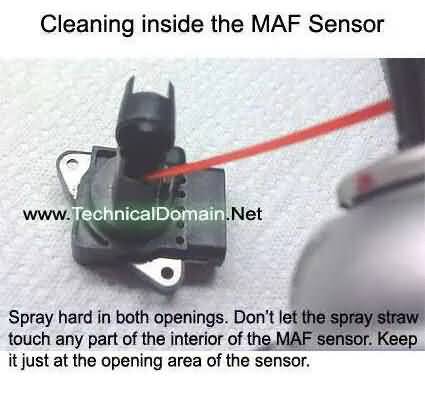
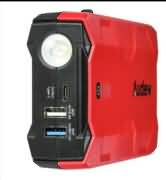



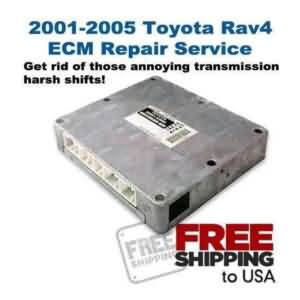
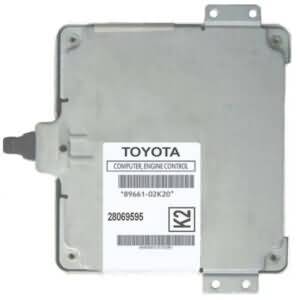
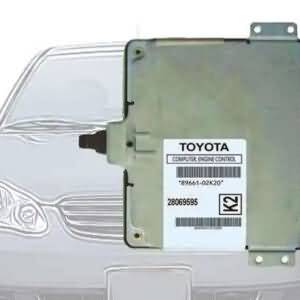

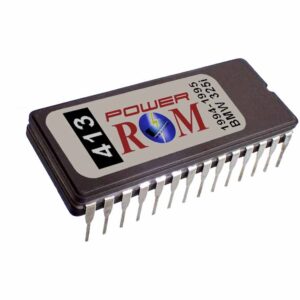
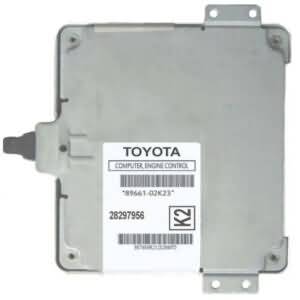
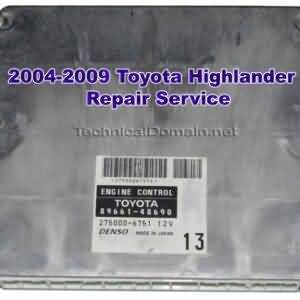

My Toyota corolla 2002 model hesitates and jerks when accelerating. Mainly the way you have already described. I serviced it at 97k ( on 105k now) and have changed one coil all spark plugs (again) had it compression tested (results can out fine) I also changed the MAF but it’s still got the same problem. Do you think it’s something major? Please can you help? And no lights are on the dash board.
I’m having the same problem as described by Imram. I have a toyota echo 2001 with 2NZ-FE_1.3_L engine. Is this simply bad fuel quality?
Does this problem have any thing to do with fuel pump found in the fuel tank?
Thanks for your prompt response.
Same problem, only I have a 2008 chevy trailblazer.. Not sure where the MAF is located…
Im having exactly this same problems but on my 95 honda civic any ideas of how I can fix it?
Unlike the rest of the commenters here, I actually read your post and did what you said. Worked like a charm – thanks!!
My 2005 Echo suddenly started stalling when accelerating. Read this article, opened the MAF sensor. There was actually a clump of dust hanging from one of the electrodes inside the sensor tunnel. Just blew it off, put the sensor back and the issue was gone! Thank you.
Thank you for your comments Serge.
I have a Nissan Armada that does the same thing. I cleaned the MAF myself and it did help for about 2 days. I then replaced it and that help for 1 day. Evidently not the issue with my vehicle. Anyone found another solution?
Your o2 sensor might be bad…
Help – Toyota Corolla diesel verso 2005 – losing power the air flow sensor has been replaced it got worse and without it drives fine which is not the answer!
Hello Sue. If I correctly understand, your car loose power with the old flow sensor and it gets worse with the new one, but it drives fine without any sensor at all? If that is the case, I can only think that the old sensor is bad and the replacement sensor is either not original, it is not for your model or it is failing too. Injected fuel amount is controlled by the ECU, taking the flow sensor as reference. A bad sensor, or a sensor with different values (different calibration) will give problems.
had the same problem with my toyota wish 2005, so i changed the sparkplugs and cleaned the maf sensor and the problem was solved
Just did this for a 1999 Toyota Vitz, seems to work straight off. Car had a lag every time you accelerated, and once a while it just wouldn’t accelerate from a stop, until you really put your foot down.
Thanks for the advice!
HI,
I have Toyota yaris saloon(2007) and it gives same issue when it is in the heavy traffic only. i replaced the Lamda 1 sensor, clean the fuel filter and Clean MAF sensor too. But still am getting this issue but few mins after it will get ok and really difficult to replicate it. am really worried about this case and expecting your kind help on this.
Thanks,
Thilanka
Same problem as Thilanka. Although I’ve only cleaned the MAF sensor as described. Car hesitates from standstill for a little while. Then car drives normally after
John
A new technology introduced by one of the biggest automobile companies, Volvo, will ensure that your
car avoid accidents on the roads involving pedestrians.
Strict standards and excellence in service is what made Cullitons
the premiere limo service of choice for thousands of Torontonians as
well as visiting guests from all over the world. This is a rear-wheel drive car, and that means that unlike front-wheel drive cars – which
typically can’t be used much beyond B class – the MR2 can be upgraded all the way to the top of A – although going into S class
is probably a bit much.
My Rav4 hesitates too but at top speeds i get no hesitation, air flow meter is replaced but i still hesitates,fuel pump replaced but still ,i have spent so much already and want expert advice before my next move
Guys. Have a 1.8 Corolla 2008. Had this problem on and off for months. Changed plugs oill and air filter . Took out the FAM and blew it clean. Problem solved. No more jerking. Thanks to your information guys. Will buy electrokleen on Monday. Cheers.
Thanks for this important Info… I checked everything you said…and found that some “mechanic apprentice” had installed the air filter in an “S” pattern.. not even Close to being fitted normally.. and the engine was sucking FAR too much air..displaying all these symptoms..If I put my hand across the air intake to limit flow, the engine ran flawlessly.. once the filter was fitted properly.. the engine ran perfect.. RAV4’s at least..Need air to be restricted as per manufacturers specs.
Thanks it worked like a charm
I have a 2007 toyota yaris and all the sudden I am losing power in all gears..especially going up a hill..so today..the rpms revved up to 5 with no extra pressure of the gas pedal..and then i smelled Burt rubber..then i got a flat..lol..so as far as the lose of power ..and smell..what could that be?
5 speed stick shift..forgot to say
It worked thanks
Hi, thanks so much for your article. I have a rav4 2001 model. It has acceleration issues it lags. I will Change the airflow sensor /clean it. Check light engine light is also an issue that has not been sorted but I will Change the oxygen sensor to see if this will help. Once again thanks for your article.
Hello. If the check engine light is about error codes P0420 or P0430, the is a bulletin about it. A calibration software update must be done first to see if that is the problem. Otherwise, oxygen sensors and/or catalytic converter could be the culprit, for which, unfortunately, the O2 sensors are expensive and the catalytic converter is even more expensive. So it must be diagnosed by someone with experience in these cases to prevent spending more than necessary.
The bulletin can be downloaded below:
EG010-02 Rav4 Oxygen Sensor P0420/P0430 Bulletin
Kind regards,
Richard
I have a 2002 Toyota Camry it is hesitant on take off and sometimes stalls I have already changed the MAF sensor and still has the same issue. Do you have any other suggestions I can look for?
Hello Jennifer.
Well, assuming that the MAF is not damaged, hesitation like that is most of the times caused by a lack of enough fuel, too much fuel or by ignition problems.
The MAF plays its part in the lack and too much fuel situations if it’s dirty or damaged. Ignition problems can cause hesitation too, but it feels a little bit different. Lack of enough fuel is a hesitation somewhat gentle, while ignition problems hesitation is a failure with sharper movements.
If this has been happening for a while, you may check the spark plugs. If the spark plugs are dry with gray to white deposits (ash), the problem is a lack of enough fuel. This means that the air/fuel mixture is getting too lean at times and this can be caused by several factors, being one of them, the MAF sensor and/or the oxygen sensor(s).
If the spark plugs are oily, the problem is something bad at the engine, like damaged gaskets and the hesitation is caused by the ignition fouling because of the oil isolating the spark. When this happens, white smoke may come out from the exhaust once in a while.
If the spark plugs have heavy carbon deposits, the problem then is too much fuel. This may cause dark smoke coming out of the exhaust once in a while, plus the smell of raw fuel. This can be the MAF too, but implies other parts/sensors, like the oxygen sensor(s).
The spark plugs themselves might be the problem, but it is most of the times caused by other problems, like the problems listed above, especially if you are using spark plugs that are meant to last very long, like the iridium spark plugs.
Also, a good idea would be to scan the vehicle even if the check engine is not turning on, to see if there is any old code stored in memory that might point to the problem.
I hope this helps.
Kind regards,
Richard